Comets , Aurorae
Galaxies & Nebulae
Most pics courtesy of NASA
NGC 2440: Cocoon of a New White Dwarf
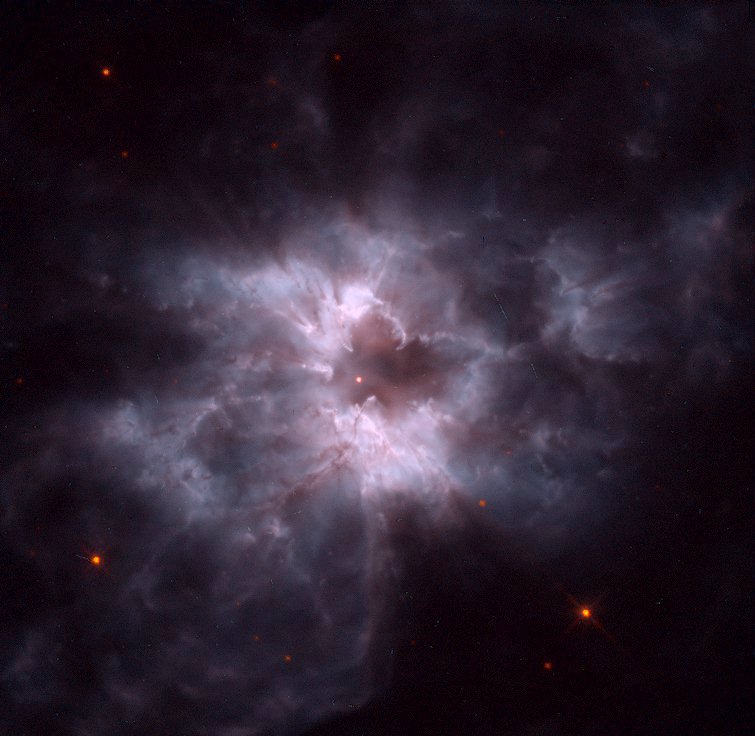

Explanation: Like a butterfly, a white dwarf star begins its life by casting off a cocoon that enclosed its former self. In this analogy, however, the Sun would be a caterpillar and the ejected shell of gas would become the prettiest of all! The above cocoon, the planetary nebula designated NGC 2440, contains one of the hottest white dwarf stars known. The white dwarf can be seen as the bright dot near the photo's center. Our Sun will eventually become a "white dwarf butterfly," but not for another 5 billion years. The above false color image and was post-processed by Forrest Hamilton.

Explanation: Comet C/1999 S4 LINEAR is only one of many comets discovered with the Lincoln Near Earth Asteroid Research (LINEAR) telescope operating near Soccoro, New Mexico, USA. Traveling steadily southward through Earth's night sky, C/1999 S4 passed perihelion (closest approach to the Sun) yesterday on what is likely its first trip through the inner solar system. Now fading, comet LINEAR became no brighter than about 6th magnitude, but is still easily visible with binoculars in northern hemisphere skies. While the memorable comets Hale-Bopp and Hyakutake were much brighter, comet LINEAR is displaying delightful tails evident in this false-color composite image from the Crni Vrh Observatory in Slovenia. The combined series of exposures made on July 22, 2000, are registered on the comet. In the resulting picture, stars appear as rows of dots, but the faint structures in the comet's tail are beautifully recorded. Presently seen moving from Ursa Major to Leo this comet LINEAR will begin to shine in southern hemisphere skies in August.

Explanation: The Whirlpool Galaxy is a classic spiral galaxy. At only 23 million light years distant and fully 65 thousand light years across, M51, also known as NGC 5194, is one of the brightest and most picturesque galaxies on the sky. The smaller galaxy appearing here below and to the left is well behind M51, as can be inferred by the dust in a foreground spiral arm blocking light from this smaller galaxy. The Whirlpool, pictured above, is visible with binoculars in the constellation of Canes Venaciti. M51 is a spiral galaxy of type Sc and is the dominant member of a whole group of galaxies. Astronomers speculate that M51's spiral structure is primarily due to its gravitational interaction with this smaller galaxy.
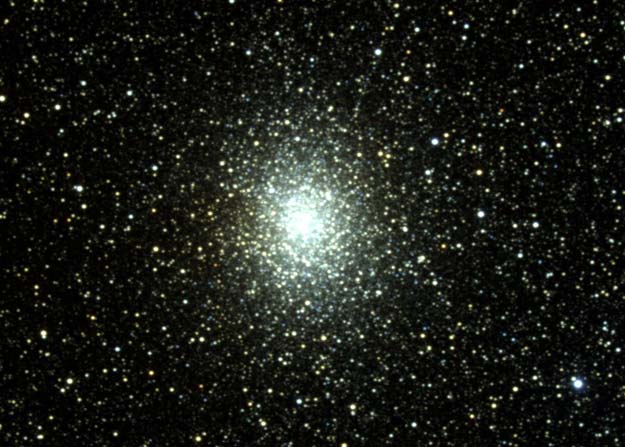
Explanation: M19 appears to be a typical globular cluster of stars - except for its shape. If one looks closely at the cluster, pictured above, it appears to be longer (top to bottom) than it is wide. In fact, M19 is the most aspherical globular cluster of the approximately 160 known orbiting the center of our Milky Way Galaxy. M19 lies about 27,000 light-years away, measures about 60 light-years across, and is home to over 100,000 stars. The cluster can be found with binoculars towards the constellation of Ophiuchus. The reason for the cluster's odd shape remains unknown, but might be related to its close (5000 light-year) proximity to the Galactic Center. Alternatively, the shape might be an illusion created by an unusual lane of dark absorbing dust on one side of the cluster.

Explanation: In the heart of the Rosetta Nebula lies a bright open cluster of stars that lights up the nebula. The stars of NGC 2244 formed from the surrounding gas only four million years ago and emit light and wind that define the nebula's appearance today. High energy light from the bright young stars of NGC 2244 ionizes the surrounding hydrogen gas clouds to create the red emission nebula appearance. The hot wind of particles that streams away from the cluster stars contributes to an already complex menagerie of gas and dust filaments while slowly evacuating the cluster center. NGC 2244 measures about 50 light-years across, lies about 4500 light-years away, and is visible with binoculars towards the constellation of Monoceros.
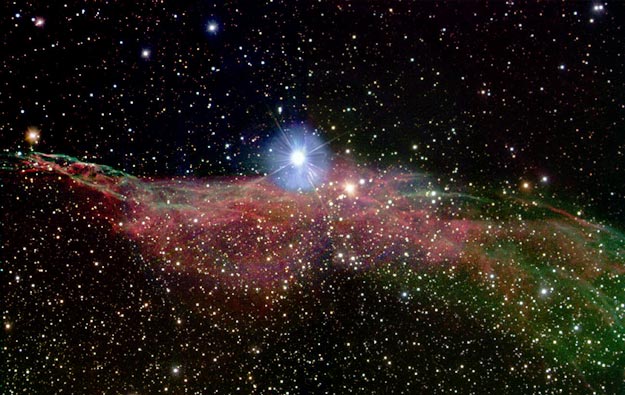
Explanation: Ten thousand years ago, before the dawn of recorded human history, a new light must suddenly have appeared in the night sky and faded after a few weeks. Today we know this light was an exploding star and record the colorful expanding cloud as the Veil Nebula. Pictured above is the west end of the Veil Nebula known technically as NGC 6960 but less formally as the Witch's Broom Nebula. The rampaging gas gains its colors by impacting and exciting existing nearby gas. The supernova remnant lies about 1400 light-years away towards the constellation of Cygnus. This Witch's Broom actually spans over three times the angular size of the full Moon. The bright blue star 52 Cygnus is visible with the unaided eye from a dark location but unrelated to the ancient supernova.
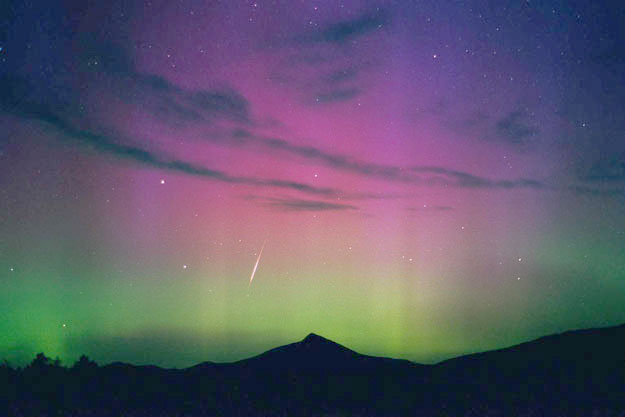
Explanation: Just after the Moon set but before the Sun rose in the early morning hours of August 12, 2000, meteors pelted the Earth from the direction of the constellation Perseus, while ions pelted the Earth from the Sun. The meteors were expected as sub-sand grains long left behind by Comet Swift-Tuttle annually create the Perseids Meteor Shower. The aurorae were unexpected, however, as electrons, protons, and heavier ions raced out from a large Coronal Mass Ejection that had occurred just days before on the Sun. In the foreground is Hahn's Peak, an extinct volcano in Colorado, USA.
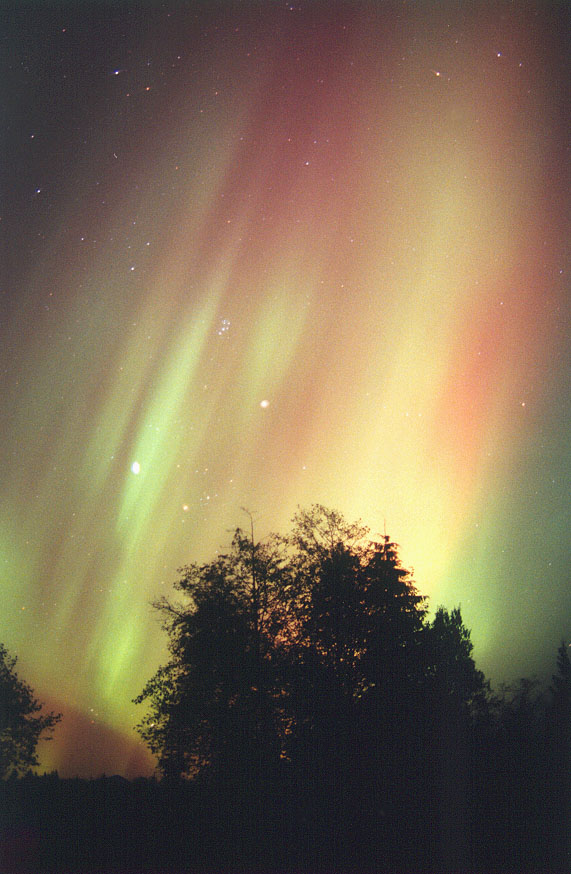
Explanation: With brilliant Venus above the western horizon at sunset and Jupiter and Saturn high in the east by early evening, November's night sky is filled with bright planets. October's sky featured bright planets as well and, triggered by the active Sun, some lovely auroral displays. This colorful aurora was recorded by Wade Clark in skies above Hamilton, Washington, USA on the night of October 4th. Through the shimmering northern lights Jupiter and Saturn are easy to spot flanking the V-shaped head of Taurus the Bull. Of course, just above lies the lovely Pleiades star cluster. Solar activity will also produce auroral shows in November, particularly at high northern and southern latitudes. Plus, November skygazers can certainly anticipate a celestial performance on the evening of the 17th/18th -- the moonlit Leonid meteor shower.
|